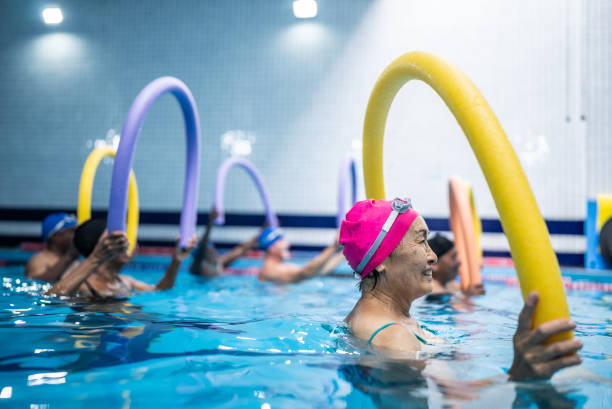As we age, our bodies naturally undergo changes that can lead to increased joint pain and muscle stiffness, significantly impacting our quality of life. However, hydrotherapy is one ancient practice that has seen a resurgence in popularity due to its remarkable benefits. Utilizing water’s unique properties, hydrotherapy involves various exercises performed in water designed to soothe, rejuvenate, and rehabilitate aging joints and muscles.
In this blog, we will explore the power of hydrotherapy as a gentle yet effective way to enhance mobility, alleviate pain, and improve overall wellness in our later years.
Contents
The Science Behind Hydrotherapy
At its core, the science behind hydrotherapy relies on water’s buoyancy, hydrostatic pressure, and thermal properties. The buoyancy provided by water reduces the effective weight borne by our joints by about 90% when submerged, significantly decreasing stress on joints and thus easing pain. This reduced weight effect allows for a greater and more comfortable range of motion during exercise.
Meanwhile, the hydrostatic pressure exerted by water on the body helps reduce swelling and improve circulation, which is crucial for healing and maintaining muscle and joint health. Lastly, the thermal properties of water, particularly warm water, can aid in relaxing muscles and increasing blood flow to affected areas, further facilitating the healing process and soothing painful areas.
Combined, these properties make hydrotherapy an ideal exercise environment for those with aging joints and muscles, promoting healing and wellness without the high impact of traditional exercise regimens.
Implementing Hydrotherapy into Your Wellness Routine

Instructor And Elderly Patient Undergoing Water Therapy Holding Inflatable In Hydrotherapy Pool
Incorporating hydrotherapy into your wellness routine is a practical and beneficial way to address the discomfort and limitations that come with aging joints and muscles. There are numerous approaches to integrating this therapeutic method into your daily life, whether it’s attending guided sessions at a local pool, engaging in water aerobics classes, or even practicing simple water-based exercises at home.
Here, we will explore various ways to effectively include hydrotherapy in your regimen, ensuring it aligns with your lifestyle and health objectives.
Starting with Hydrotherapy
Implementing hydrotherapy into your wellness routine doesn’t require significant changes. It can be as simple as visiting a local community pool that offers water aerobics classes or utilizing a hot tub for relaxation and muscle recovery. Begin by consulting with a healthcare professional to ensure hydrotherapy suits your specific health conditions.
Once cleared, start slowly, allowing your body to adjust to the new exercise medium. It’s essential to focus on movements that target your areas of concern but do not push your limits too quickly to avoid any discomfort or injury.
Benefits Beyond the Physical
While the physical benefits of hydrotherapy, such as improved joint flexibility and muscle relaxation, are well-documented, the practice also offers notable mental health benefits. Engaging in gentle water exercises can significantly reduce stress levels, promote relaxation, and improve sleep quality.
The soothing nature of water has a calming effect on the mind, offering a mental respite from the stresses of daily life. Additionally, participating in group water exercise classes can provide a sense of community and belonging, further contributing to one’s overall well-being.
Tips for Maximizing Hydrotherapy Sessions
To make the most out of your hydrotherapy sessions, consider the following tips:
- Warm Up and Cool Down: Begin each session with a gentle warm-up outside the water to prepare your muscles. Likewise, end with stretching exercises to cool down.
- Stay Hydrated: Even though you’re in the water, drinking plenty of fluids is crucial to stay hydrated during your session.
- Use the Right Equipment: Depending on the exercises, you may need equipment like water noodles, kickboards, or even water weights to enhance your workout.
- Listen to Your Body: Pay attention to how your body responds during and after exercises. Adjust your activities as needed to ensure comfort and avoid overexertion.
Integrating hydrotherapy into your wellness routine can unlock a path to improved physical and mental health, leveraging the therapeutic power of water to support your body and mind as you age.
Creating a Personalized Hydrotherapy Plan
To truly reap the benefits of hydrotherapy, it’s essential to craft a personalized plan that caters to your specific health needs and goals. A well-designed hydrotherapy regimen should consider your current physical condition, pre-existing health issues, and overall wellness objectives.
Collaboration with healthcare professionals, such as physiotherapists who specialize in aquatic therapy, can provide valuable insights and guidance in creating an effective and safe hydrotherapy plan. Remember, the goal is to use hydrotherapy to enhance your quality of life, modifying your plan as your needs and abilities evolve.
An example of a personalized hydrotherapy plan may include a mix of warm water exercises, such as leg lifts or arm circles, paired with low-impact aerobic exercises like walking or jogging in the pool. Over time, modifications can be made to increase resistance or intensity for continued progress and improvement.
Conclusion
Hydrotherapy offers a unique approach to caring for our aging joints and muscles, providing a low-impact, therapeutic environment for exercise and recovery. By understanding the science behind hydrotherapy and how to incorporate it into your wellness routine, you can unlock its benefits for both physical and mental well-being. Remember to consult with healthcare professionals, listen to your body, and create a personalized plan that aligns with your health goals. With consistency and patience, hydrotherapy can be an integral part of aging gracefully and maintaining overall wellness.
If you are in need of physical, occupational, or speech therapy services, please contact us at (920) 252-4442. We look forward to hearing from you.
